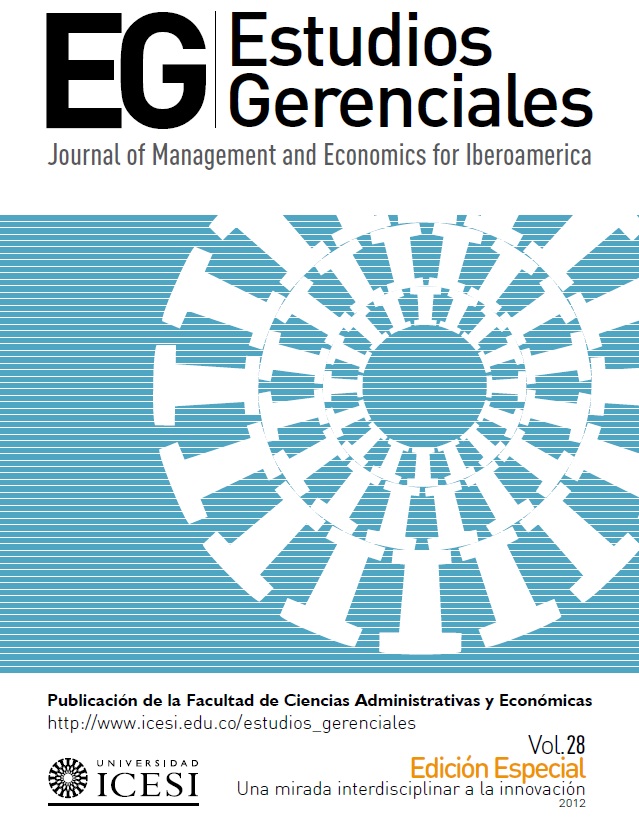Análisis bibliométrico del campo modelado de difusión de innovaciones
DOI:
https://doi.org/10.18046/j.estger.2012.1486Palabras clave:
Difusión de innovaciones, vigilancia tecnológica, bibliometría, redes de autoresResumen
El objetivo del artículo es presentar los resultados de un análisis bibliométrico en el campo del modelado de la difusión de innovaciones que permita realizar un diagnóstico de la evolución y estado actual del tema. La metodología empleada consiste en la construcción y posterior análisis de los indicadores bibliométricos de cantidad y calidad, así como un análisis de la estructura topológica de las redes de autores atendiendo a su evolución temporal en el intervalo 2005- 2011. Como resultado, se encuentra un campo en continuo crecimiento y de gran dispersión, con alta dinámica en la evolución de sus redes.
Descargas
Referencias
Balci, O. (2001). A Methodology for certification of Modeling and Simulation Applications. ACM Transactions on Modeling and Computer Simulation, 11(4), 352-377.
Barabâsi, A.L., Jeong, H., Néda, Z., Ravasz, E., Schubert, A. & Vicsek, T. (2002). Evolution of the social network of scientific collaborations. Physica A: Statistical Mechanics and its Applications, 311(3-4), 590–614.
Bass, F.M. (1969). A new product growth for model consumer durables. Management Science, 15(5), 215-227.
Castrillón-Estrada, J.A., García-Domínguez, J.C. & Anaya-Taborda, M. (2008). Databases, search engines and indexes: key tools for medical practice. Revista Salud Uninorte, 24(1), 96-119.
Chao, C.C., Yang, J.M. & Jen, W.Y. (2007). Determining technology trends and forecasts of RFID by a historical review and bibliometric analysis from 1991 to 2005. Technovation, 27(5), 268–279.
Cheong, F. & Corbitt, B.J. (2009). A social network analysis of the co-authorship network of the Pacific Asia Conference on Information Systems from 1993 to 2008. PACIS 2009 Proceedings, 23.
Daim, T.U., Rueda, G., Martin, H. & Gerdsri, P. (2006). Forecasting emerging technologies: Use of bibliometrics and patent analysis. Technological Forecasting and Social Change, 73(8), 981–1012.
Dalpé, R. (2002). Bibliometric analysis of biotechnology. Scientometrics, 55(2), 189–213.
Ding, Y., Chowdhury, G.G. & Foo, S. (2001). Bibliometric cartography of information retrieval research by using co-word analysis. Information processing & management, 37(6), 817–842.
Durieux, V. & Gevenois, P.A. (2010). Bibliometric Indicators: Quality Measurements of Scientific Publication 1. Radiology, 255(2), 342.
Frost, M.D. (1919). The Epidemiology of Influenza. Journal of the American Medical Association, 73(5), 313-318.
Garfield, E. (1955). Citation Indexes for Science. Science, 122(3159), 108-111.
Gilbert, N. & Troitzsch, K.G. (2005). Simulation for the Social Scientist (2a ed.). Berkshire, UK: McGraw-Hill.
Glanzel, W. (2003). Bibliometrics as a research field. A course on theory and application of bibliometric indicators, Magyar Tudományos Akadémia, Course Handouts. Disponible en http://nsdl.niscair.res.in/bitstream/123456789/968/1/Bib_Module.
Hall, M. (2011). Publish and perish? Bibliometric analysis, journal ranking and the assessment of research quality in tourism. Tourism Management, 32(1), 16-27.
Kemp, R. & Volpi, M. (2008). The diffusion of clean technologies: a review with suggestions for future diffusion analysis. Journal of Cleaner Production, 16(1), S14–S21.
Lee, S., Yoon, B. & Park, Y. (2009). An approach to discovering new technology opportunities: Keyword-based patent map approach. Technovation, 29(6-7), 481–497.
Leon, A.M., Castellanos, O.F. & Vargas, F.A. (2006). Evaluating, selecting and relevance software tools in technology monitoring. Ingeniería e Investigación, 26(1), 92-102.
MacVaugh, J. & Schiavone, F. (2010). Limits to the diffusion of innovation: A literature review and integrative model. European Journal of Innovation Management, 13(2), 197–221.
Meade, N. & Islam, T. (2006). Modeling and forecasting the diffusion of innovation-A 25-year review. International Journal of Forecasting, 22(3), 519–545.
Montalvo, C. & Kemp, R. (2008). Cleaner technology diffusion: case studies, modeling and policy. Journal of Cleaner Production, 16(1), S1–S6.
Norris, M. & Oppenheim, C. (2007). Comparing alternatives to the Web of Science for coverage of the social sciences' literature. Journal of Infometrics, 1(2), 161–169.
Norton, M. (2000). Introductory concepts in information science. Asis Monograph Series. Medford, NJ: Information Today.
OECD. (2005). Oslo manual: Guidelines for collecting and interpreting innovation data. Paris: Autores.
Okubo, Y. (1997). Bibliometric Indicators and Analysis of Research Systems: Methods and Examples. OECD Science, Technology & Industry Working Papers, 1-70.
Peres, R., Muller, E. & Mahajan, V. (2010). Innovation diffusion and new product growth models: A critical review and research directions. International Journal of Research in Marketing, 27(2), 91-106. doi:10.1016/j.ijresmar.2009.12.012
Rao, K.U. & Kishore, V.V.N. (2010). A review of technology diffusion models with special reference to renewable energy technologies. Renewable and Sustainable Energy Reviews, 14(3), 1070-1078.
Rueda, G., Gerdsri, P. & Kocaoglu, D.F. (2007). Bibliometrics and Social Network Analysis of the Nanotechnology Field. Management of Engineering and Technology, Portland International Center for, 2905–2911.
Savoy, J. (2005). Bibliographic database access using free-text and controlled vocabulary: an evaluation. Information processing & management, 41(4), 873–890.
Schroter, S. (2006). Importance of free access to research articles on decision to submit to the BMJ: survey of authors. BMJ, 332(7538), 394-396. doi:10.1136/ bmj.38705.490961.55.
Tan, K.C., Goudarzlou, A. & Chakrabarty, A. (2009). Bibliometric analysis of service science research: Focus on contribution from Asia. Industrial Engineering and Engineering Management, 2009. IEEM 2009. IEEE International Conference on, 1273–1276.
Van Raan, A.F.J. (2005). Fatal attraction: Conceptual and methodological problems in the ranking of universities by bibliometric methods. Scientometrics, 62(1), 133–143.
Walters, W.H. (2007). Google Scholar coverage of a multidisciplinary field. Information Processing & Management, 43(4), 1121–1132.
Publicado
Número
Sección
Licencia
Los autores de artículos serán responsables de los mismos, y por tal no comprometen los principios o políticas de la Universidad Icesi ni las del Comité Editorial de la revista Estudios Gerenciales. Los autores autorizan y aceptan la cesión de todos los derechos a la revista Estudios Gerenciales, tanto en su publicación impresa como electrónica. Luego de publicado el artículo, puede ser reproducido sin autorización, mencionando autor(es), título, año, volumen, número y rango de páginas de la publicación, y como fuente: Estudios Gerenciales (abstenerse de usar Revista Estudios Gerenciales).








